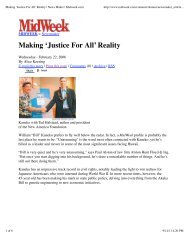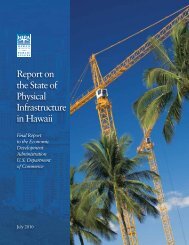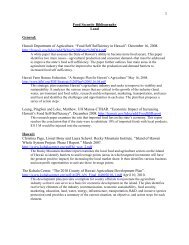Hawai'i Fisheries Initiative - The Hawaii Institute for Public Affairs
Hawai'i Fisheries Initiative - The Hawaii Institute for Public Affairs
Hawai'i Fisheries Initiative - The Hawaii Institute for Public Affairs
Create successful ePaper yourself
Turn your PDF publications into a flip-book with our unique Google optimized e-Paper software.
Consumers of recreational and subsistence<br />
fishery products are at risk both from<br />
natural toxins and from environmental<br />
contaminants. <strong>The</strong>re is a risk of ciguatera<br />
due to consumption of fish that feed on or<br />
near tropical reefs and prey upon reef fish.<br />
Ciguatera originates in certain algae, which<br />
is consumed by marine finfish. Those<br />
most commonly associated with ciguatera<br />
are groupers, barracuda, snappers, jacks,<br />
mackerel, and triggerfish. 74<br />
Other health and safety concerns include<br />
environmental contaminants (industrial<br />
and municipal discharges, agricultural<br />
practices, and storm water runoff),<br />
chemical pollutants, and heavy metals,<br />
such as mercury in swordfish. 75 Improving<br />
the regulatory scheme through measures<br />
such as HACCP programs provides a<br />
near-term means of managing the safety<br />
risks associated with seafood consumption;<br />
longer-term solutions must be directed at<br />
controlling and ultimately stopping disposal<br />
of human and industrial waste into the<br />
world’s fresh and marine waters. 76<br />
Educating Seafood Consumers<br />
In 2005, the U.S. Department of Agriculture<br />
began en<strong>for</strong>cing country of origin labeling<br />
(COOL) requirements <strong>for</strong> seafood products.<br />
<strong>The</strong> COOL law requires retailers to label<br />
seafood with its country of origin and<br />
whether it was wild or farmed. 77 <strong>The</strong>re is<br />
currently no USDA organic standard <strong>for</strong><br />
seafood; if labels read “organic,” this is<br />
likely a certification by agencies based in<br />
other countries. 78 Seafood labeling –<br />
including COOL-required, safety, and<br />
eco-labeling – have clearly become<br />
important marketing tools that can work <strong>for</strong><br />
the benefit of Hawai‘i’s commercial fishing<br />
industry through educating local consumers.<br />
Cryofresh, marketed to be FDA HACCP and<br />
European Union compliant, is a patented<br />
“tasteless smoke” product developed<br />
by Hawai‘i International Seafood to<br />
suspend oxidation in seafood so it can<br />
be frozen, stored, and later thawed. <strong>The</strong><br />
primary components of tasteless smoke<br />
are nitrogen, oxygen, carbon monoxide,<br />
carbon dioxide, and methane. In addition,<br />
tasteless smoke contains trace levels<br />
of various phenols and hydrocarbons.<br />
Tasteless smoke is said to “capture the<br />
fresh-like characteristics of color, taste, and<br />
texture of just-caught seafood.” Seafood<br />
can be stored in freezers and will maintain<br />
its fresh look and marketability <strong>for</strong> three to<br />
five days after thawing. 79<br />
Fish must be distinguished – either through<br />
a label or counter card – as containing<br />
tasteless smoke or carbon monoxide to<br />
promote color retention; fish can’t be called<br />
“fresh” or “fresh frozen” if they contain<br />
either of these preservatives. In the late<br />
1990s, as the preservation processes were<br />
becoming prevalent in the marketplace,<br />
the FDA, Hawai‘i Department of Health,<br />
and the fresh-seafood industry pushed <strong>for</strong><br />
labeling and notice measures, concerned<br />
that unscrupulous importers could use CO<br />
or tasteless smoke treatments to make old<br />
fish appear fresher and dupe consumers .80<br />
22







